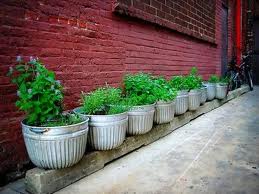
Storage: Wash the herbs in cool (not cold) water right before you’re ready to use them. Pat them dry with paper towels. For storage up to a week, treat them like flowers: trim off the ends of the stems on the diagonal. Then arrange in a vase or glass in an inch of water. Loosely cover with a plastic bag to keep clean but allow for air circulation.
General Guidelines for Cooking with Fresh Herbs:
- Dried herbs are stronger than fresh. Powdered herbs are stronger than crumbled. Use this general formula for substituting fresh herbs in recipes: 1/4 teaspoon powdered dried herbs = 1 teaspoon crumbled dried herbs = 1 tablespoon finely chopped fresh herbs.
- Everyone has a different opinion, so experiment with small amounts and see what you like.
- Generally, it’s not good to mix two very strong herbs together. However, one strong and other milder flavors tend to complement both the stronger herb and the food.
- The weaker the flavor of the main staple item, the lower the level of added seasoning required to create a pleasing balance of tastes
- Fresh herb flavors are lost by extended cooking. Add herbs to stews or soups about 45 minutes before completing the cooking. For cold foods such as dips, cheese, vegetables, and dressings, add herbs the night before or at least several hours before serving.
- To learn more about how each herb tastes, try mixing one with margarine or butter and let it sit for at least an hour. Then spread on a plain cracker.

Anise: Chicken, pork, fish, stews, beverages, stewed fruit. Seeds in baked goods.
Basil: Tomatoes and tomato dishes, vinegars, rice, eggs, meats, duck, salads, vegetables.
Chives: Salads, stews, appetizers, vegetables, butter, yogurt, and sour cream sauces.
Dill: Fish and fish sauces, scrambled eggs, cottage cheese, breads, beets, cucumbers, cauliflower, brussels sprouts, salads.
Fennel: Tomato dishes, eggs, fish, marinades for meats, carrots, pickles, breads and baked goods.
Marjoram: Stews, soups, meats, tomato dishes, vegetables, eggs, breads, French dressing.
Mint: Salads, lemonade, tea, potatoes, scallops, sauces and jelly, sherbet, lamb, fruit.
Oregano: Italian tomato sauces, barbecue sauce, soups, eggs, cheese, pork, vegetables, salad dressings.
Parsley: Tomato sauces, fish, meats and poultry, soups, stews, vegetables.
Rosemary: Lamb, pork, vegetables, chowders, cheese.
Sage: Fish, meat, poultry stuffing, chowders, soups, tomatoes.
Savory: Pork, chowders, stews, fish, eggs, salads, beans, biscuits.
Tarragon (French): Eggs, yogurt and sour cream dishes, meat, asparagus, beans, cucumbers.
Thyme (Lemon or English): Stews, clam chowder, fish, meat, poultry, eggs, stuffings, bread, biscuits, lima beans, broccoli, onions.
